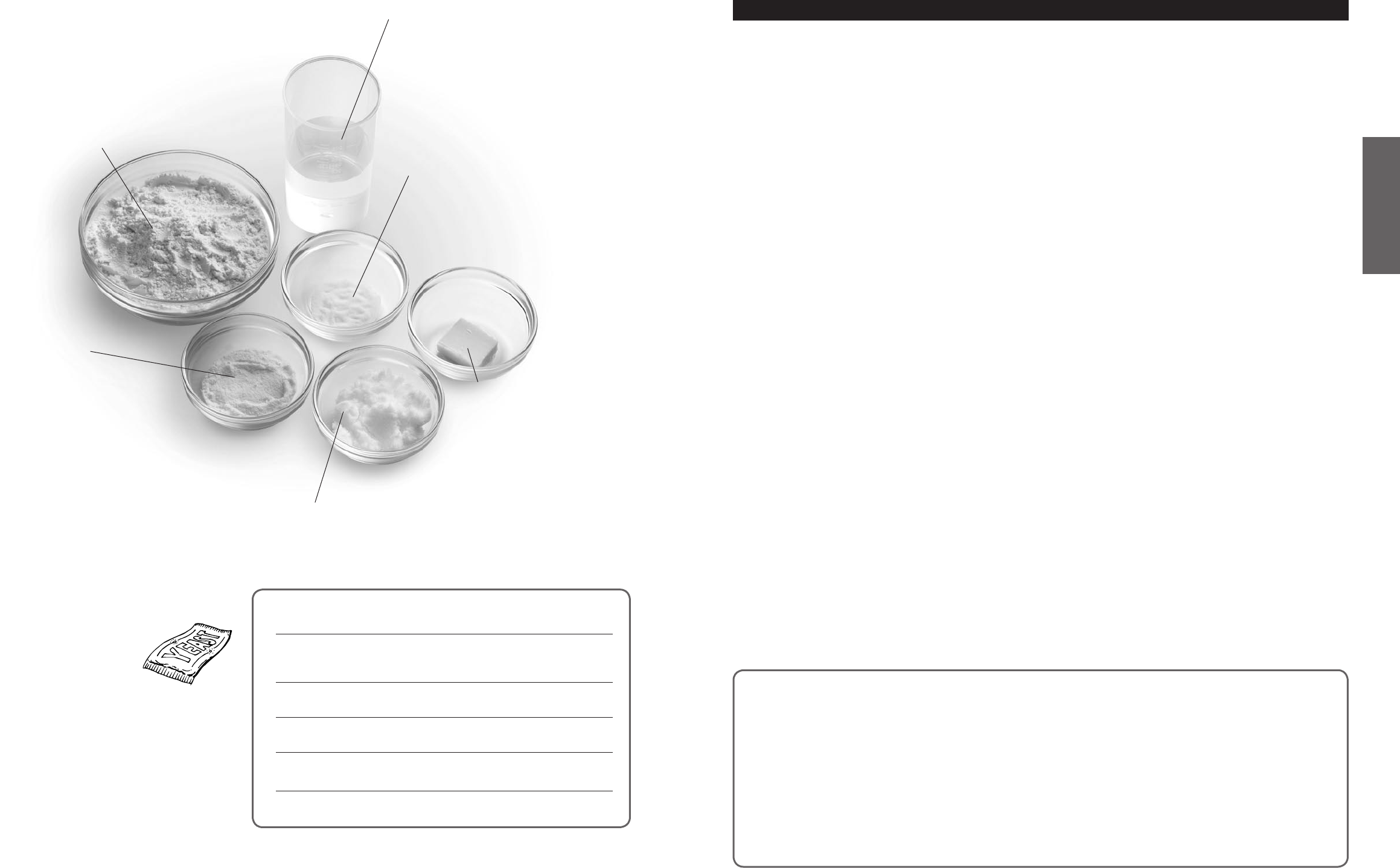
8 9
Before Use
You can make your bread taste better by adding other
ingredients:
Eggs
Improve the nutritional value and colouring of the bread.
(Water amount must be reduced proportionally)
Beat eggs when adding eggs.
Bran
Increases the bread’s fibre content.
• Use max. 50 g (2 oz).
Wheat germ
Gives the bread a nuttier flavour.
• Use max. 50 g (2 oz).
Spices,
herbs
Enhance the flavour of the bread.
• Only use a small amount (1–2 tsp).
Bread-making Ingredients
Flour
Main ingredient of bread. The protein in flour
forms gluten during kneading. Gluten provides
structure and texture and helps the bread to
rise.
Use strong bread flour only.
Flour must be weighed on scales.
Dairy
Products
Add flavour and
nutritional value.
If you use milk instead of water, the nutritional
value of the bread will be higher, but do not
use in timer setting as it may not keep fresh
overnight.
Reduce the amount of water proportionally
to the amount of milk.
Water
Use normal tap water.
Use tepid water if using menu 02, 05, 07, 12 or 20
(SD-2500: 02, 05 or 11) in a cold room.
Use chilled water if using menu 07, 08, 11, 13, 14,
20, 21, 23, 24 or 25 (SD-2500: 07, 10, 12, 13, 19.
21, 22 or 23) in a hot room.
Always measure out liquids using the measuring cup
provided.
Salt
Improves the flavour and strengthens
gluten to help the bread rise.
The bread may lose size/flavour if measuring
is inaccurate.
Fat
Adds flavour and softness to the
bread.
Use butter, margarine or oil. 2 tbsps
oil are equivalent to 25 g butter.
Sugar (granulated sugar, brown sugar, honey, treacle etc)
Adds softness and gives crust colour.
Yeast
Enables the bread to rise.
Yeast which has ‘Easy
Blend’, ‘Fast Action’ or
‘Easy Bake’ written on the
packet is recommended.
Do not use dried yeast
that requires preliminary
fermentation.
When using yeast from sachets, seal the sachet
again immediately after use. To store follow
manufacturers instructions but use opened
individual sachets within 48 hours.
Main Flours Used in Bread
Strong flour is milled from hard wheat and has a high content of protein which is necessary for the development of gluten. Carbon dioxide
produced during fermentation is trapped within the elastic network of gluten, thus making the dough rise.
White flour:
Made by grinding wheat kernel, excluding bran and germ. Used in e.g. menu 01, 08, 16 or 21 (SD-2500: 01, 07, 15 or 19).
•
Always use strong flour when using the recipes in this book.
•
Do NOT use plain or self-raising flour as a substitute for bread flour.
Wholemeal flour:
Made by grinding entire wheat kernel, including bran and germ.
Makes bread rich in minerals, but lower in height and denser than bread baked with white flour because the gluten strands are cut by the edges
of bran flakes and germ.
Rye flour:
Contains some proteins, but these do not produce as much gluten as wheat flour.
Makes dense, heavy bread with a flat or slightly sunken top crust (use in menu 07 or 20). (SD-2501 only)
•
Do not use more than stated quantity, 100 g maximum rye out of 500 g flour in SD-2500.
Spelt flour:
In the wheat family but is a completely different species genetically.
Although it contains gluten some gluten-intolerant people can digest it. (Consult your doctor.)
Makes loaves with a flat/slightly sunken crust.
Spelt wholegrain flour bread becomes low height and dense compare with spelt white flour bread.
We will recommend spelt white flour to be used more than the half of the entire flour.
•
There is Spelt (Triticum spelta) suitable for baking bread and Einkorm wheat (Triticum monococcum: also it is called small spelt) which is not
suitable for baking bread are sold as spelt. Please use spelt. [use in menu 13, 14, 24 or 25 (SD-2500: 12, 13, 22 or 23)]
Brown flour: 10–15% of wheat grain removed during milling.
Softgrain flour:
Strong white flour with wheat and rye grains added. Provides extra fibre, texture, and flavour.
•
Do not use with ‘Timer’ option (grains can absorb water and swell up, spoiling texture of loaf).
Granary
®
or Malted Grain flour:
Has crushed wheat or rye grains added together with malted whole wheat.
Makes brown bread coarser and moister with nuttier flavour.
•
Do not use more than stated quantity (could damage the bread pan’s non-stick finish).
Stoneground flour:
Grains are crushed between two large millstones rather than with steel rollers.
•
Do not use more than stated quantity (could damage the bread pan’s non-stick finish, or overload motor).
Other flour:
Products milled from other grains (i.e. corn meal, rice, millet, soy, oat, buckwheat, barley flours).
•
Do not use more than stated quantity (hinders rising and texture).
•
Should not be used as substitute for bread flour.
•
Gluten Free - see P. 28.
Coarse ingredients such as flours with whole grains or the addition of nuts and seeds may damage the bread pan’s non-stick finish.
If using a bread mix...
Bread mixes including yeast
Place a 500 g mix in the bread pan, then add water.
(Follow instructions on the packet for the quantity of
water)
Select menu 02– ‘Large’ size setting.
With some mixes, it is not clear how much yeast is
included, so results may vary.
Baking brioche with brioche mix
Select menu 11 (SD-2500: 10) or 02 – ‘Medium’ size –
‘Light’ crust colour.
Bread mix with separate yeast sachet
First place the measured yeast in the bread pan, then the
bread mix, then the water.
•
Bread Maker Capacity
400–600 g mix (for a loaf), 250–600 g mix (for a dough)
Set the machine according to the type of flour included in
the mix, and start the baking.
•
White flour, brown flour
menu 01
•
Whole wheat, multi grain flour
menu 04
•
rye flour
menu 07 (SD-2501 only)


















